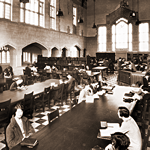|
|
UBC’s official colours are blue and gold. Why blue and gold? The answer goes back to UBC’s first year (1915-16) — but in fact, the colours almost became green, black, and gold, owing to a misunderstanding. On October 26, 1915, the Chairman of UBC’s Committee on Academic Costume wrote a letter to UBC President Wesbrook recommending green, black, and gold as the University colours. This letter was referred to the University Faculty, but at a meeting on November 10, 1915, the Faculty referred the matter back to the Committee for reconsideration. On November 29, the Committee reported back to the Faculty, somewhat apologetically, saying that they had originally not seen the new University coat of arms and had been “under a misapprehension” about its colour scheme. They now recommended that the University colours be blue and gold, to conform with the colours on the coat of arms. The UBC coat of arms (or crest) had been chosen by President Wesbrook himself. He based it on the coat of arms for the province, which shows a setting sun and three wavy blue lines representing the sea, beneath a Union Jack. Wesbrook replaced the Union Jack with an open book and the words “Tuum Est” (UBC’s motto, meaning “It’s yours” or “It’s up to you”). But he kept the golden sun and the blue waves [1]. On receiving the recommendation that the University colours be blue and gold in conformity with the University crest, the Faculty gave its approval, subject to approval by the AMS Student Council and the University Senate. On February 14, 1916, the Faculty were told that the AMS Student Council had asked that the blue in the University’s colours be made more specifically “a deep rich Royal blue.” However, the Committee on Academic Costume told the Faculty that “because of the difficulty of reproducing special shades of blue in fabrics and printed material, considerable latitude in these respects is permissible so long as there is no pronounced departure from the official shades,” and it simply reiterated its recommendation that the University colours be “the blue and gold of the University crest.” The Faculty passed along this recommendation to the Senate, which approved it on February 16, 1916. The new official colours became especially associated with UBC’s sports teams, which were often referred to in the Ubyssey as the Blue and Gold. The Ubyssey ran an editorial on November 27, 1919, urging students to support the UBC sports teams, “the wearers of the blue and gold.” On December 19, 1918, the Ubyssey told its readers to “get your blue and gold ribbons out” to cheer on the rugby and basketball teams. In 1921, the AMS adopted a bylaw describing the “Official University Sweater to be worn by any student of U.B.C.” Boys were to wear a V-neck pullover, the body of which was to be in blue, with a gold collar and cuffs and a gold band around the bottom. Girls’ sweaters were to be white, but with blue collars and gold bands. Several songs were even written referring to the University’s colours, most notably “Hail to the Gold and Blue,” and also “My Girl’s a Hullabaloo,” which begins:
They don’t write songs like that anymore. Footnotes
|
